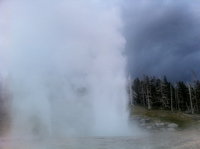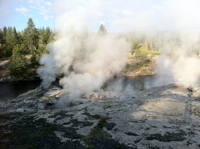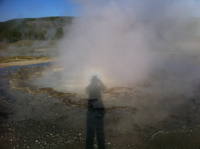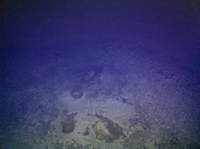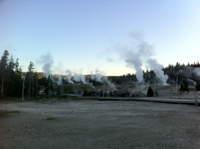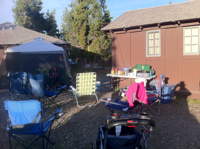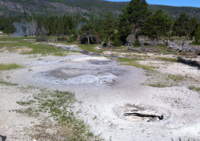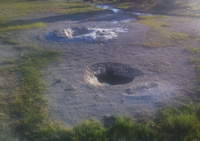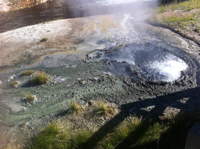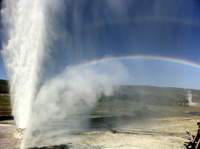So after an extremely short interval, it only follows that the next interval would feature an eruption of Rift and an interval at the other extreme of the range. I was awakened well before the alarm by thunder and the pounding of large drops on the cabin roof, but fortunately, by the time I headed out, the clouds had broken and the moon was visible.
Got out in time to catch West Triplet in eruption, shortly followed by Rift. With Sawmill pounding away beyond, that meant that any silence during the wait was out of the question, as Percolator continued long after Rift ended, and Sputnik added its own voice even after everything else finally did die down.
Other than another visit from the night coyote, who this time went behind the benches instead of through the runoff, it was a dull wait. I kept looking down to see any changes in the steam to the north, but nothing, not even a Grotto start.
The moon had long set by the time Grand did erupt, but at least it wasn't another one burst eruption. It was another one of those quick starts where, based on the runoff sounds, the pool was full early and Grand started explosively before Turban.
It appears that people were out at F&M for the night, as shortly before Grand I saw a bike leave that area headed in, and someone did get the start time. It was a bit of a relief after yesterday to hear that it had erupted in the dark.
Went out a little early for Grand, since it might take advantage of the early West Triplet window like it did yesterday. No such luck, and while West Triplet was in eruption when I got out there, it ended without Grand, and that meant we'd be waiting for the next West Triplet. Another uneventful wait, although some of the people passing by provided entertainments-- First, were a couple coming from the north walking their bikes, shortly afterwards we got a dogleg being walked out into the basin. It was at about the same time, maybe even from the doglet-walker, that the question of the day was asked, "Which is the way to Old Faithful?"
After about 8-1/2 hours we got the first true Turban delay that I've seen this year. At only 26 minutes, but Grand had waves for about 8 of them, and West Triplet was also showing water. It was as if they weren't quite in sync enough, that either Grand was ready too early for West Triplet, or that West Triplet was running late and wasn't prepared for Grand to make an attempt. In any case, shortly before the second Turban was due, West Triplet started, and Grand had another one of those quick fills that leads to an eruption. In this case, a nice, short two burst. The pool drained immediately, there wasn't even the stopped drain as Vent and Turban continued on.
All during the wait Sawmill was erupting, and the group itself was going into a Deep Drain. Shortly before Grand it finally quit. After Grand, as we were walking toward it, it began erupting again, this time from an empty crater. We weren't close enough to see those bursts well, and by the time got over next to it, Sawmill was already overflowing.
During the afternoon we had our first False Indicator. It only lasted about a minute, but came at less than eight hours since the previous Beehive eruption. Now we just need the full hour eruption at a time when Beehive is expected. On the other hand, Little Squirt is active again today, and some are hoping that it, along with some of the other Geyser Hill activity is a sign of an impending Giantess eruption.
Conditions for the evening eruption of Grand didn't look very good.There were thick clouds overhead, and the weather maps showed that they weren't going to disappear soon. But there was no rain, and by the time I went out, it looked like things might clear after dark. But it turns out it didn't matter. I saw Turban erupting as I was tying down my bike. The Sawmill Group was going through another Deep Drain, and I watched Sawmill for a while put up bursts in the 40 to 50 foot range. By the time I got to Grand, it was already in overflow for the next Turban eruption.
And it just sat there. Nicely full, all the ridges covered, but no waves and no indication that it wanted to erupt or not. I'd come out early with the expectation of there being a possible West Triplet window, but more likely that I'd be seeing Rift and get to wait for the clouds to clear and the moon to come out. So wasn't surprised that West Triplet did start a few minutes later. Also expected the delay to be just that, a delay. But finally, small waves appeared, and when Turban started, it had the "time for an eruption" sound it makes as Grand starts to overflow heavily and to boil.
So it made up some of yesterday's excessively short interval by having a short interval, but one for which I was there.
The eruption itself could have been spectacular if the sun had been out, but even so, the one burst made a nice contrast against the gray sky.

